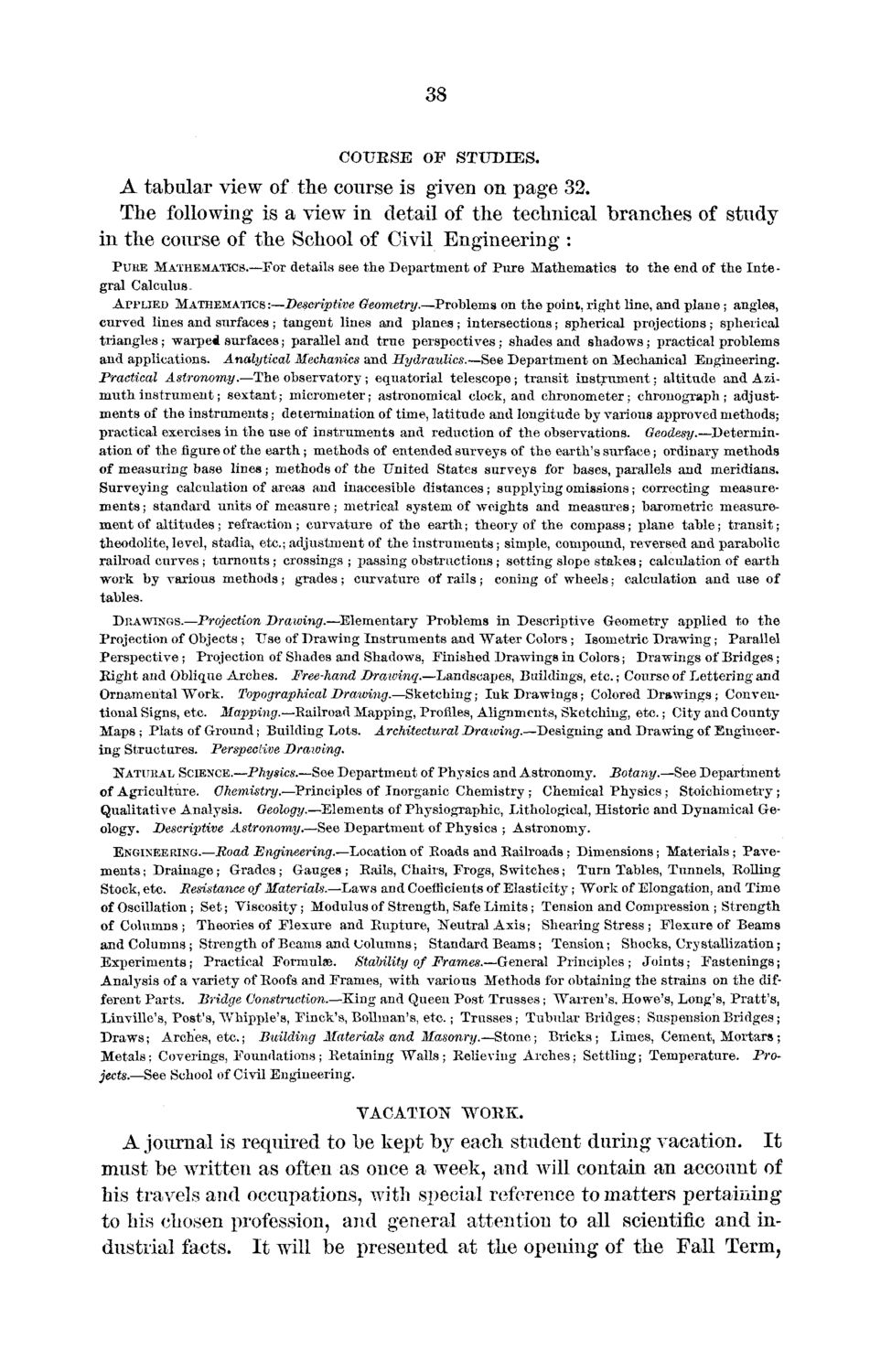| |
| |
Caption: Board of Trustees Minutes - 1872
This is a reduced-resolution page image for fast online browsing.

EXTRACTED TEXT FROM PAGE:
38 COURSE OF STUDIES. A tabular view of the course is given on page 32. The following is a view in detail of the technical branches of study in the course of the School of Civil Engineering : PURE MATHEMATICS.—For details see the Department of Pure Mathematics to the end of the Inte gral Calculus. APPLIED MATHEMATICS -.—Descriptive Geometry.—Problems on the point, right line, and plane; angles, curved lines and surfaces ; tangent lines and planes; intersections; spherical projections; spherical triangles ; warped surfaces; parallel and true perspectives ; shades and shadows; practical problems and applications. Analytical Mechanics and Hydraulics.—See Department on Mechanical Engineering. Practical Astronomy.—The observatory ; equatorial telescope ; transit instrument; altitude and Azimuth instrument; sextant; micrometer; astronomical clock, and chronometer; chronograph; adjustments of the instruments; determination of time, latitude and longitude by various approved methods; practical exercises in the use of instruments and reduction of the observations. Geodesy.—Determination of the figure of the earth; methods of entended surveys of the earth's surface; ordinary methods of measuring base lines; methods of the United States surveys for bases, parallels and meridians. Surveying calculation of areas and inaccesible distances; supplying omissions; correcting measurements ; standard units of measure; metrical system of weights and measures; barometric measurement of altitudes; refraction ; curvature of the earth; theory of the compass; plane table; transit; theodolite, level, stadia, etc.; adjustment of the instruments; simple, compound, reversed and parabolic railroad curves ; turnouts ; crossings ; passing obstructions ; setting slope stakes; calculation of earth work by various methods; grades; curvature of rails; coning of wheels; calculation and use of tables. DRAWINGS.—Projection Drawing.—Elementary Problems in Descriptive Geometry applied to the Projection of Objects ; Use of Drawing Instruments and Water Colors; Isometric Drawing; Parallel Perspective; Projection of Shades and Shadows, Finished Drawings in Colors; Drawings of Bridges; Right and Oblique Arches. Free-hand Draivinq.—Landscapes, Buildings, etc.; Course of Lettering and Ornamental Work. Topographical Drawing.—Sketching; Ink Drawings; Colored Drawings ; Conventional Signs, etc. Mapping.—Railroad Mapping, Profiles, Alignments, Sketching, etc.; City and County Maps ; Plats of Ground; Building Lots. Architectural Drawing.—Designing and Drawing of Engineering Structures. Perspective Drawing. NATURAL SCIENCE.—Physics.—See Department of Physics and Astronomy. Botany.—See Department of Agriculture. Chemistry.—Principles of Inorganic Chemistry ; Chemical Physics ; Stoichiometry; Qualitative Analysis. Geology.—Elements of Physiographic, Lithological, Historic and Dynamical Geology. Descriptive Astronomy.—See Department of Physics ; Astronomy. ENGINEERING.—Road Engineering.—Location of Roads and Railroads; Dimensions; Materials ; Pavements ; Drainage; Grades; Gauges ; Rails, Chairs, Frogs, Switches; Turn Tables, Tunnels, Rolling Stock, etc. Resistance of Materials.—Laws and Coefficients of Elasticity; Work of Elongation, and Time of Oscillation ; Set; Viscosity; Modulus of Strength, Safe Limits; Tension and Compression ; Strength of Columns ; Theories of Flexure and Rupture, Neutral Axis; Shearing Stress ; Flexure of Beams and Columns ; Strength of Beams and Columns; Standard Beams; Tension; Shocks, Crystallization; Experiments; Practical Formulae. Stability of Frames.—General Principles ; Joints; Fastenings; Analysis of a variety of Roofs and Frames, with various Methods for obtaining the strains on the different Parts. Bridge Construction.—King and Queen Post Trusses; Warren's. Howe's, Long's, Pratt's, Linville's, Post's, Whipple's, Finck's, Bollman's, etc.; Trusses; Tubular Bridges; Suspension Bridges; Draws; Arches, etc.; Building Materials and Masonry.—Stone; Bricks; Limes, Cement, Mortars; Metals; Coverings, Foundations ; Retaining Walls ; Relieving Arches; Settling; Temperature. Projects.—See School of Civil Engineering. VACATION WORK. A journal is required to be kept by each student during vacation. I t must be written as often as once a week, and will contain an account of his travels and occupations, with special reference to matters pertaining to his chosen profession, and general attention to all scientific and industrial facts. It will be presented at the opening of the Fall Term,
| |